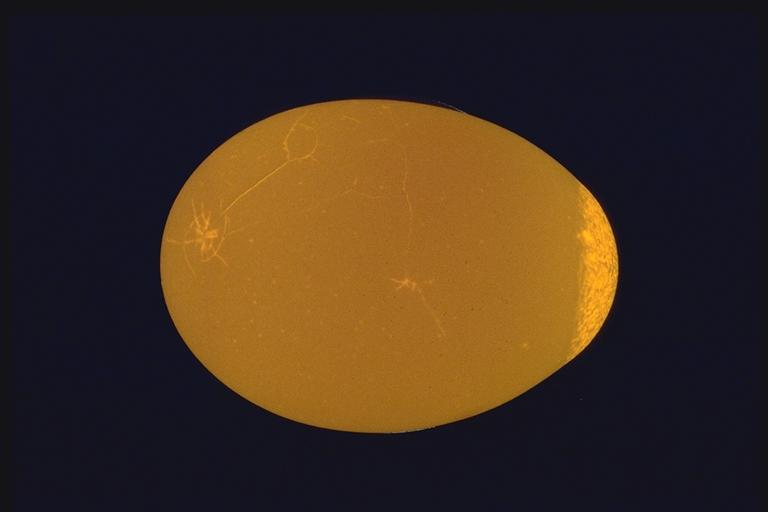Cracked Eggs and Your Small Flock of Laying Hens
PDF Version (43KB)
Cracked eggs are annoying because of the mess that they create in nests, egg baskets and egg cartons. They are a concern for the people who eat eggs because cracked eggs are more likely to contain salmonella – especially if they have been improperly washed.
When you are faced by a cracked egg problem you need to investigate both the quality of the eggs produced by the hens and your method of handling the eggs after they have been laid. One tool that helps to investigate these problems is an egg candler. A candler is a specially designed light that will help you to see the small as well as the large cracks. When looking into cracked egg problems, you want to find the small cracks because they can easily turn into large ones as you collect, wash, and grade the eggs. An egg candler can be purchased through many chick/feed supply dealers as well as mail order catalogues. A high quality egg candler costs about $200.

Egg inspected with egg candler. Fresh and fine cracks are much easier to see.
1) Hens and Cracked Eggs
If you find large numbers of cracks in eggs that are carefully gathered by hand from the nests or cages, your hens are a possible source of the problem. For a 60 week old flock, it is normal to find cracks in 4% of the eggs examined at the nest or cage. If the number of cracked eggs is high, possible causes include:
- Old Hens – Shell strength steadily declines as your hens age. Only going into a moult will temporarily reverse this decline. By 60 weeks of age, many hens that have been in continuous production will lay eggs with markedly weaker shells.
- Egg Size – Extra Large and Jumbo sized eggs crack more often than Large sized eggs. These big eggs hit the nest or cage floor harder and roll faster out of the cages. They are more likely to get pinched or squeezed in egg baskets or trays.
- Hen Laying Preference – Many hens squat to lay their eggs but some prefer to stand. Eggs laid by standing hens fall further and crack more.
- Excitable Hens – Hens that are disturbed, especially during the evening hours, produce poor quality shells.
- Weak Shells – Nutrition and feeding programs can help or hurt shell quality. See the article, “Weak Shells and Your Small Laying Hen Flock.”
Management and proper feeding can reduce these problems but cannot stop in the inevitable decline in shell quality as your hens age.
2) Cracks and Egg Handling
Even if shell quality is good, you may still find large numbers of cracked eggs at the cage or nest. Nests require 5 cm or more of bedding material to provide a soft landing area for the eggs. Cage floors must be designed and installed to prevent too steep of a slope. The floors must be free of broken wires and sturdy enough to stop eggs from getting stuck in the cage. Deep cages often have more cracks than shallow cages.
After looking at the nests and cages, you should examine how the eggs are being gathered, washed, and graded. The eggs must be collected at least twice a day so that they do not hit other eggs as they are laid in the nest or roll out of the cage. The gatherings should be spaced so that approximately equal numbers of eggs are gathered each time. For example, if your lights come on at 6 a.m., you may want to collect eggs at 8 a.m. and noon. You should not gather the eggs too quickly or pile them too high in egg baskets. If you use egg trays, put the eggs small end down, keep the Jumbo eggs in separate trays, and do not stack the trays more than six high. If you wash your eggs, the wash water should not be more than 12°C warmer than the eggs or thermal cracks may occur. Careful handling during washing, weighing and packing is essential.

